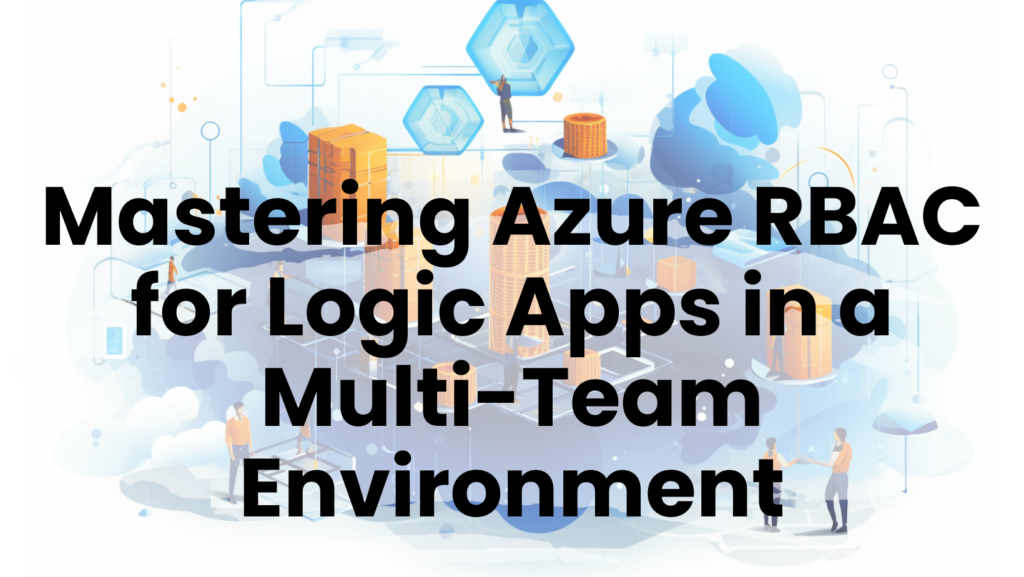
Introduction
Part 1 of Mastering Azure RBAC
Azure Role-Based Access Control (RBAC) is a crucial component for managing access and permissions in Azure resources, including Logic Apps.
Controlling Access to Logic Apps with Azure RBAC
Controlling Access to Logic Apps
with Azure RBAC
RBAC promotes effective collaboration among various teams and stakeholders. It allows each group, including developers, DevOps teams, testers, and others, to have appropriate roles and permissions, enabling them to collaborate efficiently while respecting the security boundaries of each environment.
Role Assignment
Azure RBAC comes into play. The organization uses Azure RBAC to assign appropriate roles to individuals or groups for each Logic App.
Resource Isolation
To ensure resource isolation and maintain a secure environment, the organization needs to restrict access to each Logic App to its respective team. This isolation prevents one team from inadvertently affecting another team’s Logic App.
Auditing and Compliance
With RBAC, the organization can track who has access to each Logic App, what actions they can perform, and when these actions occur. This audit trail is crucial for compliance and security purposes.
Role Assignment Examples
- Developers under the “Developer” role, allows them to create and modify Logic Apps.
- Administrators under the “Contributor” role, have full control over the Logic App’s settings and access management.
- Business analysts under the “Reader” role, could view and monitor the Logic App’s performance without making changes.
Fine-grained control
Fine-Grained Control: Azure RBAC allows for fine-grained control, enabling the organization to customize permissions based on the specific requirements of each Logic App.
Dynamic Role Assignment
RBAC also supports dynamic role assignments based on Azure AD groups, which can simplify access management. For instance, all members of the “DevOps Team” group could automatically receive the “Contributor” role for DevOps-related Logic Apps.
Scalability
As the organization’s Logic Apps portfolio grows, Azure RBAC ensures that access management remains scalable and manageable.
Emergency Access
In case of urgent situations, Azure RBAC allows for temporary role escalation, granting additional permissions to address issues and then reverting them when the crisis is resolved.
Regular Review
Regularly reviewing and adjusting RBAC assignments ensures that permissions
remain aligned with the team’s roles and responsibilities.
Logic App RBACs:
LOGIC APP CONSUMPTION
-
Logic App Operator: Can trigger and run Logic Apps.
-
Logic App Contributor: Can manage, update, and monitor Logic Apps.
LOGIC APP STANDARD
- Logic App Standard Reader (Preview): View-only access to all Logic App resources, including workflow history.
- Logic App Standard Operator (Preview): Manage workflows, resubmit them, and configure API connections, but no changes to app settings.
- Logic App Standard Developer (Preview): Create and update workflows and API connections but can’t make app-wide changes.
- Logic App Standard Contributor (Preview): Full management access, except for changing access permissions.

Conclusion
Take Action!
By implementing Azure RBAC for Logic Apps, the organization can achieve efficient, secure, and compliant management of their workflow automation processes while accommodating the needs of various teams and individuals within their organization.
Make sure you see ‘How to configure RBAC for LogicApps’ for more in depth information!
Interested in our
Approach & Solutions?
Don’t settle when it comes to making critical decisions.
Get in Touch – and explore the possibilities!
Seamless Integrations
Customer centricity
Microsoft Partner
Tailor-made solutions
Industry Pioneer
Agile Approach
Data Insights
Architecture Excellence
Experience
